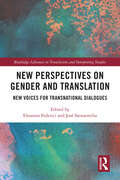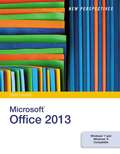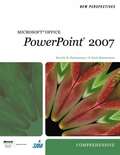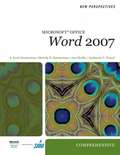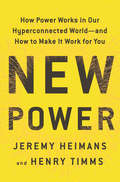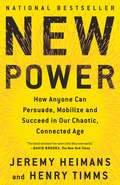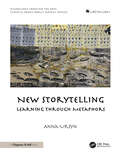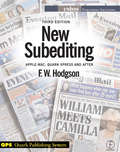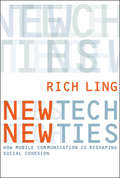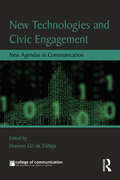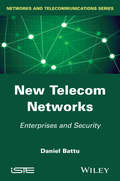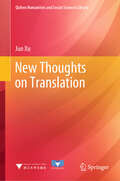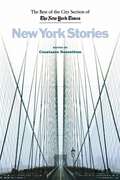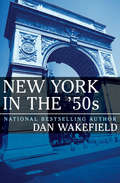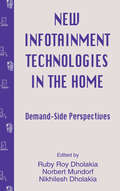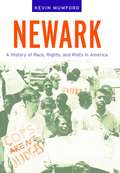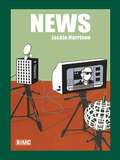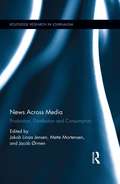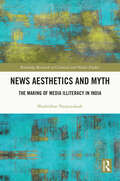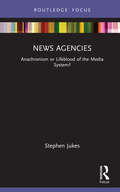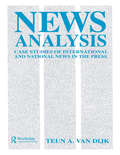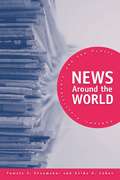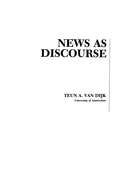- Table View
- List View
New Perspectives on Gender and Translation: New Voices for Transnational Dialogues (Routledge Advances in Translation and Interpreting Studies)
by Eleonora Federici and José SantaemiliaThis collection expands the body of research on the intersection of gender and translation to highlight perspectives across different countries in Europe, showcasing developments in the field from its origins in the emergence of feminist translation in Quebec over the last thirty years. Building off seminal work on feminist translation by scholars in Canada in the 1980s and 1990s, the book explores the evolution of the discipline in shifting translation practices and research across a range of European countries, with a focus on underrepresented areas such as Malta, Serbia, and Poland. The different chapters examine key developments such as the critical reframing of gender and identity, the viewing of historical translation activity by women through the lens of ideological and political motivations, and the analysis of socio-political contexts where feminist or gender-inspired translation has impacted translators’ practices. The volume looks concurrently at the European context and beyond it, putting the spotlight on new voices in translation and gender research in the region but also encouraging transnational dialogues on key issues in the discipline, pushing the field further into new directions. This book will be of particular interest to scholars in translation studies, gender studies, and European literature.
New Perspectives on Microsoft® Office 2013 (First Course)
by The Editors at the Cengage LearningThe Series' critical-thinking, problem-solving approach is the ideal way to prepare students to transcend point-and-click skills and take advantage of all that Microsoft Office 2013 has to offer.
New Perspectives on Microsoft® Office PowerPoint® 2007: Comprehensive
by Beverly B. Zimmerman S. Scott ZimmermanFollowing the critical thinking, problem-solving approach of the New Perspectives Series learners will gain a comprehensive understanding of Microsoft PowerPoint 2007, including the new features of the software. The case-based tutorials challenge learners to apply what they are learning to real-life tasks, preparing them to easily transfer skills to new situations. With the New Perspectives Series approach, learners understand why they're learning what they're learning, and are better situated to retain skills.
New Perspectives on Microsoft® Office Word 2007: Comprehensive
by Katherine T. Pinard Ann Shaffer Beverly B. Zimmerman S. Scott ZimmermanFollowing the critical thinking, problem-solving approach of the New Perspectives Series learners will gain a comprehensive understanding of Microsoft Word 2007, including the new features of the software. The case-based tutorials challenge learners to apply what they are learning to real-life tasks, preparing them to easily transfer skills to new situations. With the New Perspectives Series approach, learners understand why they?re learning what they?re learning, and are better situated to retain skills.
New Power: How Power Works in Our Hyperconnected World--and How to Make It Work for You
by Jeremy Heimans Henry TimmsFrom two influential and visionary thinkers comes a big idea that is changing the way movements catch fire and ideas spread in our highly connected world.For the vast majority of human history, power has been held by the few. "Old power" is closed, inaccessible, and leader-driven. Once gained, it is jealously guarded, and the powerful spend it carefully, like currency. But the technological revolution of the past two decades has made possible a new form of power, one that operates differently, like a current. "New power" is made by many; it is open, participatory, often leaderless, and peer-driven. Like water or electricity, it is most forceful when it surges. The goal with new power is not to hoard it, but to channel it. New power is behind the rise of participatory communities like Facebook and YouTube, sharing services like Uber and Airbnb, and rapid-fire social movements like Brexit and #BlackLivesMatter. It explains the unlikely success of Barack Obama's 2008 campaign and the unlikelier victory of Donald Trump in 2016. And it gives ISIS its power to propagate its brand and distribute its violence. Even old power institutions like the Papacy, NASA, and LEGO have tapped into the strength of the crowd to stage improbable reinventions. In New Power, the business leaders/social visionaries Jeremy Heimans and Henry Timms provide the tools for using new power to successfully spread an idea or lead a movement in the twenty-first century. Drawing on examples from business, politics, and social justice, they explain the new world we live in--a world where connectivity has made change shocking and swift and a world in which everyone expects to participate.
New Power: How Power Works in Our Hyperconnected World--and How to Make It Work for You
by Jeremy Heimans Henry TimmsIn this indispensable guide to navigating the twenty-first century, two visionary thinkers reveal the unexpected ways power is changing--and how "new power" is reshaping politics, business, and life.Why do some leap ahead while others fall behind in our chaotic, connected age? In New Power, Jeremy Heimans and Henry Timms confront the biggest stories of our time--the rise of mega-platforms like Facebook and Uber; the out-of-nowhere victories of Obama and Trump; the unexpected emergence of movements like #MeToo--and reveal what's really behind them: the rise of "new power."For most of human history, the rules of power were clear: power was something to be seized and then jealously guarded. This "old power" was out of reach for the vast majority of people. But our ubiquitous connectivity makes possible a different kind of power. "New power" is made by many. It is open, participatory, and peer-driven. It works like a current, not a currency--and it is most forceful when it surges. The battle between old and new power is determining who governs us, how we work, and even how we think and feel. New Power shines fresh light on the cultural phenomena of our day, from #BlackLivesMatter to the Ice Bucket Challenge to Airbnb, uncovering the new power forces that made them huge. Drawing on examples from business, activism, and pop culture, as well as the study of organizations like Lego, NASA, Reddit, and TED, Heimans and Timms explain how to build new power and channel it successfully. They also explore the dark side of these forces: the way ISIS has co-opted new power to monstrous ends, and the rise of the alt-right's "intensity machine."In an era increasingly shaped by new power, this groundbreaking book offers us a new way to understand the world--and our role in it.
New Storytelling: Learning through Metaphors
by Anna UrsynThere is a global need to become less fearful of coding, as it improves communication with the coders on the job and helps with prompt writing, which hiring companies often request. This set of story-based learning projects links performances and tasks with computing codes to show how a machine translates our goals into its language. Metaphors link instructions telling a computer what task to perform with similar functions in other disciplines. The materials serve those in Computer Graphics, Digital Media, or anyone interested in understanding and becoming familiar with principles and the logic behind coding, and help understand machines when writing a prompt. Dance, music, and performing visually present knowledge through stories and serve as a metaphor for understanding how coding and current technologies affect various disciplines. By introducing basic ideas behind programming in a symbolic way, this book shows how computing and nature overlap through storytelling.Most jobs are collaborative, and coding involves many parts of production processes. These knowledge-based stories improve communication between the artists and the coders to bridge the gap between them.It is a part of the “Knowledge Through the Arts” series, consisting of:Dance Code - Dance Steps as a CodeNew Storytelling - Learning Through MetaphorsCode Appreciation - Reshaping KnowledgeNature Appreciation - Knowledge as Art
New Subediting: For Quark Users
by F W HodgsonNew Subediting gives a detailed account of modern editing and production techniques. Its aim is both to help the young subeditor and to spell out to the newcomer to newspaper journalism what happens between the writing of news stories and features and their appearance in the newspaper when it comes off the press. In this age of technological change the quality of the subbing has never been more important to a successful newspaper. The careful use of typography, pictures, graphics and compelling headlines and the skillful handling of text coupled with good page planning, all help to give character,style and readability.This book examines, and draws lessons from, work in contemporary newspapers in editing and presentation; it defines the varied techniques of copytasting, of editing news stories and features, of styles of headline writing and the use of typography to guide and draw the attention of the reader. It takes into account developments in the use of English as a vehicle of mass communication in two important chapters on structure and word use; and it shows how to get the best out of the electronic tools now available to subeditors.It also reminds journalisis that, however advanced the tools, a newspaper is only as good as the creative skills of those that write, edit and put it together.
New Tech, New Ties
by Rich LingThe message of this book is simple: the mobile phone strengthens social bonds among family and friends. With a traditional land-line telephone, we place calls to a location and ask hopefully if someone is "there"; with a mobile phone, we have instant and perpetual access to friends and family regardless of where they are. But when we are engaged in these intimate conversations with absent friends, what happens to our relationship with the people who are actually in the same room with us? In New Tech, New Ties,Rich Ling examines how the mobile telephone affects both kinds of interactions--those mediated by mobile communication and those that are face to face. Ling finds that through the use of various social rituals the mobile telephone strengthens social ties within the circle of friends and family--sometimes at the expense of interaction with those who are physically present--and creates what he calls "bounded solidarity." Ling argues that mobile communication helps to engender and develop social cohesion within the family and the peer group. Drawing on the work of Emile Durkheim, Erving Goffman, and Randall Collins, Ling shows that ritual interaction is a catalyst for the development of social bonding. From this perspective, he examines how mobile communication affects face-to-face ritual situations and how ritual is used in interaction mediated by mobile communication. He looks at the evidence, including interviews and observations from around the world, that documents the effect of mobile communication on social bonding and also examines some of the other possibly problematic issues raised by tighter social cohesion in small groups.
New Tech, New Ties: How Mobile Communication Is Reshaping Social Cohesion (The\mit Press Ser.)
by Richard LingHow cell phones and mobile communication may in many cases strengthen social cohesion.The message of this book is simple: the mobile phone strengthens social bonds among family and friends. With a traditional land-line telephone, we place calls to a location and ask hopefully if someone is “there”; with a mobile phone, we have instant and perpetual access to friends and family regardless of where they are. But when we are engaged in these intimate conversations with absent friends, what happens to our relationship with the people who are actually in the same room with us? In New Tech, New Ties, Rich Ling examines how the mobile telephone affects both kinds of interactions—those mediated by mobile communication and those that are face to face. Ling finds that through the use of various social rituals the mobile telephone strengthens social ties within the circle of friends and family—sometimes at the expense of interaction with those who are physically present—and creates what he calls “bounded solidarity.” Ling argues that mobile communication helps to engender and develop social cohesion within the family and the peer group. Drawing on the work of Emile Durkheim, Erving Goffman, and Randall Collins, Ling shows that ritual interaction is a catalyst for the development of social bonding. From this perspective, he examines how mobile communication affects face-to-face ritual situations and how ritual is used in interaction mediated by mobile communication. He looks at the evidence, including interviews and observations from around the world, that documents the effect of mobile communication on social bonding and also examines some of the other possibly problematic issues raised by tighter social cohesion in small groups.
New Technologies and Civic Engagement: New Agendas in Communication (New Agendas in Communication Series)
by Homero Gil de Zuniga NavajasThis volume contributes to the extant and prolific New Agendas in Communication Series from one of the most salient perspectives within the field of Communication: New Technologies and Civic Engagement. The impact of the Internet and other technological advances are constantly referred to at most junctures of today's Communication research agendas. The area of Political Communication is not immune to this trend. The effects of the Internet and digital media on today's political landscape, with a particular emphasis on enhancing individuals’ civic duties and engagement levels, are theme of concern at many of the most renowned journals in Communication and Political Science disciplines. First, this book pays attention to the overall impact of the Internet and people's use of digital media and new technologies to analyze civic life at large, reconceptualizing what citizenship is today. Secondly, and more specifically, participants shed light over the intersection of a number of current new agendas of research in regards to some of the most rapidly growing technological advances (i.e., new publics and citizenship), and the emergence of sprouting structures of citizenship. The volume shows the implications that new technological advances carry with respect the possibilities, patterns and mechanisms for citizen communication, citizen deliberation, public sphere and civic engagement.
New Telecom Networks
by Daniel BattuNowadays, the Internet has become an irreplaceable tool, feeding us information about new innovations and the evolution of the markets relating to all human activities. What the Internet lacks, though, is a guiding narrative thread, which is crucial to understand the evolution from old technologies into the technologies available today, and to benefit from the commentary which could elucidate that process of evolution. In spite of its inherent richness, no encyclopedia can constitute the one and only referential information source. The actors involved also have the right to be heard: all those who have devoted their working lives to the collective effort of edifying networks can, of course, present their personal views about the evolution of the world of telecommunications, and thus provide invaluable testimony to companies in this area who can make use of it. It is that approach which is adopted in this book. Whilst the primary objective of this book is to encourage SMEs to use digital technologies, and help them to organize with that goal in mind, it has proved necessary to describe the transformations currently under way in the field of networks, and to outline the efforts to obtain a competitive edge in terms of clerical applications, compare the various techniques that are available for high data rate communications, and touch upon the advent of the "Internet of Things", cloud computing and various new multimedia technologies. All in all, this book should help companies - particularly SMEs - to garner overall information about the current movement in the area of networking, and assist them in putting in place and managing their own communications systems.
New Thoughts on Translation (Qizhen Humanities and Social Sciences Library)
by Jun XuThis book represents the cutting-edge ideas on translation studies in recent years from China’s pioneer translator Xu Jun. The book discusses the following points: first of all the theoretical thinking of translation studies, second the translation methods and challenges in the new era, and then the translation spirit and critical exploration, followed by translation education, translation value, and others. It serves as a reference book for scholars and readers who are dedicated in thoughts about developing China’s translation studies.
New York Stories: The Best of the City Section of the New York Times
by Constance RosenblumThese forty essays from the New York Times&’ City section tell &“stories of human life in all its quirky richness&” (The Boston Globe). Featuring a cast of stellar writers, this collection brings some of the best essays from the City section to readers beyond the five boroughs. New York Stories profiles people like sixteen-year-old Barbara Ott, who surfs the waters off Rockaway in Queens, and Sonny Payne, the beloved panhandler of the F train. Other essays explore memorable places, from the Greenwich Village townhouse blown up by radical activists in the 1970s to a basketball court that serves as the heart of its Downtown neighborhood. The forty essays collected here reflect an intimate understanding of the city, one that goes beyond the headlines. The result is a passionate, well-written portrait of a legendary and ever-evolving place. Contributors include: Andre Aciman, Thomas Beller, Laura Shaine Cunningham, Jim Dwyer, Jill Eisenstadt, Vivian Gornick, Chuck Klosterman, Robert Lipsyte, Phillip Lopate, Jan Morris, Richard Price, Joe Queenan, Suzanne Vega, Meg Wolitzer, and more &“Unassuming, elegant dispatches, suffused with a wise but unsentimental affection.&”—The New Yorker &“All of the pieces are engrossing . . . This is both an excellent addition to New York history and a pleasure for casual browsing.&” ―Publishers Weekly
New York in the '50s
by Dan WakefieldThe rhythms of jazz and beat poetry punctuate this sweeping, firsthand account of New York City&’s 1950s literary scene from the Bowery to Spanish Harlem National bestselling author Dan Wakefield first came to New York City in 1952 with the intention of receiving a proper literary education on the ivied campus of Columbia University. An equally enlightening experience, he quickly found, was hiding in the smoky bars and cafés of Greenwich Village frequented by the most talented writers of the fifties, including James Baldwin, Joan Didion, and Allen Ginsberg. Wakefield recounts drinking at the White Horse Tavern, Dylan Thomas&’s Village haunt, as well as the offices of Esquire and the Nation, capturing rare, intimate moments of spirited camaraderie between some of the most influential artists of their generation. Like Hemingway&’s recollections of 1920s Paris in A Moveable Feast, New York in the &’50s showcases a city in its artistic heyday, replete with Wakefield&’s remembrances of brushing shoulders with literary icons such as Jack Kerouac and Norman Mailer, and watching Thelonious Monk play jazz at the Five Spot Café. Wakefield&’s experience as a journalist and chronicler of Americana allows him to capture the subtleties of a decade of unparalleled artistic expression.
New infotainment Technologies in the Home: Demand-side Perspectives (Routledge Communication Series)
by Ruby Roy Dholakia Nikhilesh Dholakia Norbert MundorfAs the "information superhighway" moves into the home through interactive media, enhanced telecom services, and hybrid appliances, interest continually grows in how consumers adopt and use Information Technology (IT), the strategies IT marketers use to reach consumers, and the public policies that help and protect consumers. USE COPY FROM THIS POINT ON FOR GENERAL CATALOGS... This book presents a unique collection of papers dealing with the demand side issues of new information technologies in the home. The contributors are from business, academia, and the public policy sector and represent many disciplines including communication, marketing, economics, psychology, engineering, and information systems. This book provides one of the best introductions to complex issues such as: * business forces that will shape "Home IT" of the future; * industry structure of the future "Infotainment" mega-business; * factors affecting consumer adoption and use of IT; * international differences in the management of the IT sector; and * public policies that will shape the deployment and use of IT.
Newark: A History of Race, Rights, and Riots in America
by Kevin MumfordNewark's volatile past is infamous. The city has become synonymous with the Black Power movement and urban crisis. Its history reveals a vibrant and contentious political culture punctuated by traditional civic pride and an understudied tradition of protest in the black community. Newark charts this important city's place in the nation, from its founding in 1666 by a dissident Puritan as a refuge from intolerance, through the days of Jim Crow and World War II civil rights activism, to the height of postwar integration and the election of its first black mayor. In this broad and balanced history of Newark, Kevin Mumford applies the concept of the public sphere to the problem of race relations, demonstrating how political ideas and print culture were instrumental in shaping African American consciousness. He draws on both public and personal archives, interpreting official documents--such as newspapers, commission testimony, and government records--alongside interviews, political flyers, meeting minutes, and rare photos. From the migration out of the South to the rise of public housing and ethnic conflict, Newark explains the impact of African Americans on the reconstruction of American cities in the twentieth century.
Newhouse: All the Glitter, Power, and Glory of America's Richest Media Empire and the Secretive Man Behind It
by Thomas MaierThis book explores the history of the Newhouse family-a family that went from near poverty to amassing a media fortune of 13 billion. The Newhouse media empire includes influential magazines, book publishing houses, newspapers, and cable oulets. The book chronicles the Newhouse family story in a facinating must read style.
News
by Jackie HarrisonFrom an author highly knowledgeable in the field, News is a handy and accessible guide that examines the history of news, both as newspapers and radio, and as entertainment and information, and introduces students to the key concepts and issues that surround the news. Using up-to-date case examples such as the Hutton Report and embedded journalists, from across a range of media including print, radio, television and the internet, Jackie Harrison explains the different theoretical approaches that have been used to study the news, as well as providing an accessible introduction to how news is produced and regulated, what counts as news, and how it is selected and presented. Topics covered include: introduction to the concept of news the growth and development of news technology, concentration and competition balancing freedom and responisibility regulatory control of the news making the news. Written in a clear and lively style, News is the ideal introductory book for students of media, communication and journalism.
News Across Media: Production, Distribution and Consumption (Routledge Research in Journalism)
by Mette Mortensen Jakob Linaa Jensen Jacob ØrmenNews production, distribution and consumption are in rapidly changing due to the rise of new media. This book examines how these processes become more and more interrelated through logics of dissemination, sharing and co-production. These changes have the potential to affect the criteria of newsworthiness as well as existing power structures and relations within the fields of journalism and agenda setting. The book discusses changing logics of production, from citizens’ as well as journalists’ perspectives, examines distribution and sharing as a link between but also an intrinsic part of production and consumption, and addresses the changing logics of consumption. Contributors place such changes in a historical perspective and outline challenges and future research agendas.
News Aesthetics and Myth: The Making of Media Illiteracy in India (Routledge Research in Cultural and Media Studies)
by Shashidhar NanjundaiahThis book considers the presence of media illiteracy in a world in which we are supposedly consumed by media, live a media life, in a media ecosystem, surrounded by mediated communication.Unpacking this paradoxical situation, the author proposes that before venturing into media literacy, we must first understand the workings of how mystification occurs. Departing from the idea that aesthetics work on an agreed set of principles between art and society, the author applies this ideology of aesthetics to news-based narration. Using empirical cases from India, the author proposes demystification as a possible methodology to approach media illiteracy and recommends completely transformed media literacy programs that deliver to communities, drawing from the construct of critical pedagogy. The book offers the possibilities for a collectivistic, non-Western, postcolonialist model of learning by using the very collective and hierarchical identities of societies that must be critiqued.This vital and innovative book will be an important resource for scholars and students in the areas of media literacy and critical media literacy, media education, journalism, mass communication, aesthetics and media technology.
News Agencies: Anachronism or Lifeblood of the Media System? (Disruptions)
by Stephen JukesThis book explores the role of international news agencies and investigates whether they have been able to adapt to the contemporary media landscape following the disruption wrought by fake news, social media and an increasingly polarised public discourse. News Agencies addresses the key players in the industry, beginning with the ‘big three’ (Reuters, The Associated Press and Agence France-Presse) and then moving on to the newest global player, Bloomberg. It also explores the role of alternative providers of international news which are seeking to challenge the Western-centric perspective of the agencies. Drawing on interviews with senior editors, Jukes investigates the challenges agencies face in terms of their editorial strategy and business models in today’s social media context. At a time when there is widespread distrust in the media and agencies are relying increasingly on user-generated content as a source for news, Jukes critically explores the role of these agencies in the debate over fake news and policies on objectivity, impartiality and verification. Shedding light on a sector of the news industry that has steadfastly remained out of the public spotlight, this book will be of interest to students and academics in the fields of journalism and media studies.
News Analysis: Case Studies of international and National News in the Press (Routledge Communication Series)
by Teun A. van DijkFirst Published in 1987. Routledge is an imprint of Taylor & Francis, an informa company.
News Around the World: Content, Practitioners, and the Public
by Pamela J. Shoemaker Akiba A. CohenWhat's news? A front-page news story in the United States might not appear in a newspaper in China. Or a minor story on German television may be all over the airwaves in India. But News Around the World shows that the underlying nature of news is much the same the world over and that people--no matter what their jobs or their status in society--tend to hold similar notions of newsworthiness. In this richly detailed study of international news, news makers and the audience, the authors have undertaken exhaustive original research within two cities--one major and one peripheral--in each of ten countries: Australia, Chile, China, Germany, India, Israel, Jordan, Russia, South Africa, and the United States. The nations were selected for study based on a central principle of maximizing variation in geographic locations, economic and political systems, languages, sizes, and cultures. The remarkable scope of the research makes this the most comprehensive analysis of newsworthiness around the globe: 10 countries studied, each with a university country director 2 cities in each country examined, one major and one peripheral 60 news media studied (newspapers, television, and radio news programs), resulting in 32,000+ news items analyzed 80 focus groups with journalists, public relations practitioners, and audience members 2,400 newspaper stories ranked according to newsworthiness and compared with how prominently they were published. News Around the World provides remarkable insight into how and why news stories are reported, testing and improving a theory of cross-cultural newsworthiness and is essential reading for anyone seeking to understand international media and journalism.
News As Discourse (Routledge Communication Series)
by Teun A. van DijkFirst Published in 1990. Routledge is an imprint of Taylor & Francis, an informa company.
